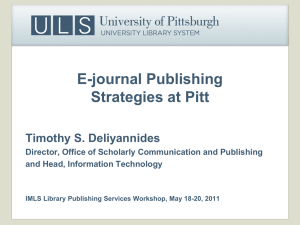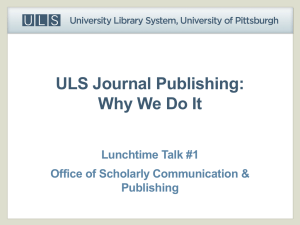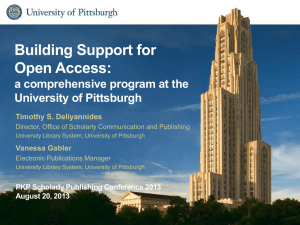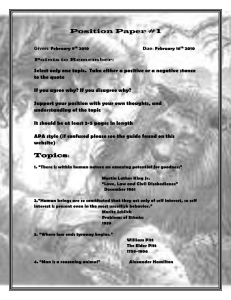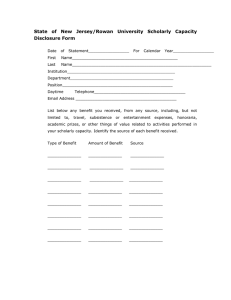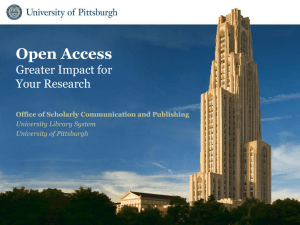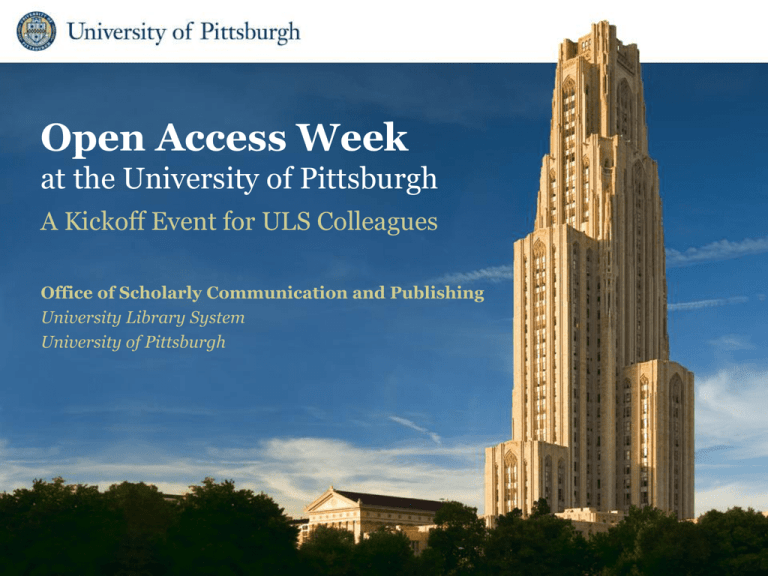
Open Access Week
at the University of Pittsburgh
A Kickoff Event for ULS Colleagues
Office of Scholarly Communication and Publishing
University Library System
University of Pittsburgh
Goals for today:
• Educate ourselves about OA
• Be familiar with OA resources at Pitt
• Learn about tools that support OA
• Know how the OSCP can help
• Get directly involved in working with Pitt
faculty and students
Open Access is…
• A family of copyright licensing policies under
which authors and copyright owners make
their works publicly available
• A movement in higher education to increase
access to scholarly research and
communication, not limiting it solely to
subscribers or purchasers of works
• A response to the current crisis in scholarly
communication
OA Overview
• Open Access literature is digital, online, free of
charge, and free of most copyright and
licensing restrictions
• Works are still covered by copyright law, but
Open Access terms apply to allow sharing and
reuse
• All major OA initiatives for scientific and
scholarly literature insist on the importance of
peer review
OA is compatible with . . .
• Copyright
• Quality
• Peer review
• Career advancement
• Revenue (even profit)
• Indexing
• Print
• And other features
and supportive
services associated
with conventional
scholarly literature
• Preservation
• Prestige
Other related terms
• Open Source—applies to computer
software
• Open Content—applies to non-scholarly
content
• Open Data—a movement to support
sharing of research data (see data.gov)
• Free Access—no charge to access, but all
rights may be reserved
Growth in scholarly publishing
• Est. 50 million scholarly research articles published
1665-2009
• @1.4 million articles per year (2006 est.)—one every
22 seconds!
• Average number of science articles per journal
increased by >47% from 1990 to 2009
(Times Higher Education, 8 July 2010)
• Number of scientific articles indexed by ISI was
590,841 in 1990 and 1,015,637 in 2009 – a rise of 72%
1990-2009
Concentration of ownership
• Nearly 50% of the content of the merged ISI
Indexes consists of titles from 5 major publishers—
–
–
–
–
–
Elsevier
Wiley
Springer
Taylor & Francis
Sage
• Top 3 publishers of science journals (Elsevier,
Springer-Kluwer, Wiley-Blackwell) accounted for
@ 42% of articles published (2002)
• There were over 2,000 publishers of academic
journals; no other publisher accounted for >3% of
market share (2002)
Crisis in scholarly journal pricing
600
biology
500
chemistry
engineering & tech
general science
300
math & comp sci
physics
200
CPI (general inflation)
ARL expenditures, all
serials
1985
1990
100
1995
2000
year
Bill Hooker, April 2009. Data sources: Library Journal Annual Serials Price
Surveys, Association of Research Libraries, US Dept. of Labor
2005
0
2010
% change since 1990
400
Open Access—Origins
• Crisis in scholarly
communication/publishing
– Flat to declining collections budgets
– More demand for newer, expensive resources
– Greatly increased pricing for serials, electronic
resources
• Rise of Internet and Worldwide Web
– Rapid dissemination of new research
– Better connectivity between scholars
OA History—Early Days
• Late 1960s/early 1970s
– ERIC, Medline, and Agricola created; ARPANET launched
• 1971
– Project Gutenberg formed
• 1991-1994
– ArXiv, mp_arc (Mathematical Physics Preprint Archive), Project
Bartleby, Perseus Project, et al., launched
• 1994
– Digital Libraries Initiative launched by National Science Foundation;
Social Sciences Research Network (SSRN) launched
• 1996
– Networked Digital Library of Theses and Dissertations, Internet
Archive created
OA History—Early 2000s
• 2000-2003: Tools
– PubMed Central launched
– First Creative Commons licenses released
– Directory of Open Access Journals launched
• 2000-2003: Declarations
– Tempe Principles for Emerging Scholarly Publishing
– UN Economic and Social Council calls for “universal access to knowledge and
information”
– Budapest Open Access Initiative
– Bethesda Statement on Open Access Publishing
– Berlin Declaration on Open Access to Knowledge in the Sciences and
Humanities
OA History—Late 2000s
• 2005
– NIH Public Access Policy goes into effect: Scientists receiving NIH
grants are asked to deposit in PubMed Central on a voluntary basis
– Wellcome Trust implements Open Access mandate for Wellcomefunded research
– Columbia University, University of Kansas, and Case Western
Reserve, adopt statements in support of OA
• 2008
– Federal mandate takes effect requiring OA for NIH-funded research
through deposit in PubMed Central
– Harvard mandates OA deposit of faculty scholarly works
• 2009
– MIT mandates OA deposit of faculty scholarly works
OA Today
• Over 150 universities around the world
mandate Open Access deposits of faculty works
• Directory of Open Access Journals (DOAJ)
– lists 6,998 OA journals in 112 countries
– http://www.doaj.org (September 2011)
• Directory of Open Access Repositories
(OpenDOAR)
– lists over 2,000 open archives in 97 countries
– http://www.opendoar.org (September 2011)
OA@Pitt—History
• 2000
– Pitt is signatory to Tempe Principles
• 2001
– Electronic Theses and Dissertations (ETDs) begin
– PhilSci-Archive launched for rapid OA
dissemination of new research in philosophy of
science; “The Pittsburgh Archive”)
• 2002
– Pitt is signatory to Budapest Open Access Initiative
– School of Engineering requires deposit of ETDs in
advance of University-wide mandate
OA@Pitt—History
• 2003
– Archive of European Integration created
• 2004
– ETDs mandated for all programs with a thesis
requirement
– Minority Health Archive launched
• 2007
– University of Pittsburgh Press begins working with
ULS to provide OA to 500 books on Press backlist
– ULS journal publishing program begins, moving
existing print journals to electronic
OA@Pitt—History
• 2008
– ULS published its first e-only Open Access journal,
International Journal of Telerehabilitation
• 2009
– Senate Plenary Session on Open Access held
– D-Scholarship@Pitt institutional repository
launched at Plenary session
– Open Access Task Force formed
– OA journal publishing increases to 8 titles
OA@Pitt—Today
• 22 Open Access journals now published with 5 more
pending; nearly all are peer-reviewed
• ULS Publications Advisory Board formed
• Archive of European Integration contains 16,000 items
• 5 author self-archiving repositories with more planned
• D-Scholarship contains more than 5,700 items
• Over 750 OA book titles through Press Digital Editions
• Over 4,200 ETDs; will be migrated to D-Scholarship by
November 2011
Total number of documents
in ULS e-publications FY2000-FY2011
40,000
35,000
30,000
25,000
20,000
15,000
10,000
5,000
FY2000
FY2001
FY2002 FY2003
FY2004
FY2005
FY2006
FY2007
FY2008
FY2009
FY2010
FY2011
Growth in the number of
ULS E-Publications
Open Access Archives
E-Journals
22
9
4
FY2000
2
FY2001
2
3
FY2002 FY2003
-
-
-
5
5
5
FY2004
FY2005
FY2006
2
5
FY2007
3
5
FY2008
6
FY2009
7
FY2010
7
FY2011
ULS Journal Publishing Goals
• Propel scholarship at the University of
Pittsburgh
• Extend service beyond the home institution
• Save ‘at-risk’ journals without the
infrastructure or know-how to go electronic
• Incentivize Open Access Publishing worldwide
Collaboration with
University of Pittsburgh Press
• 750+ University of Pittsburgh Press titles freely
available through Press Digital Editions
• Co-sponsor for all peer-reviewed journals
published by the ULS
• Director Cynthia Miller a member of ULS
Publications Advisory Board
Open Access Task Force
• Charge:
– To review issues related to open access and to
make recommendations to the University
related to the adoption of an open access
policy at Pitt.
Open Access Task Force
• Rush Miller, University Library System
(Task Force Chair)
• Michael Madison, School of Law
• Cynthia Miller, University of Pittsburgh Press
• Steven Reis, Associate Vice Chancellor for Clinical
Research, School of Medicine
• Adam Shear, Dept. of Religious Studies
• Karen Shephard, Barco Law Library
Proposed OA Policy @Pitt
• Provides for dissemination of scholarly works (articles
only) by university authors based on Open Access
principles
• Applicable only to the University schools and
responsibility centers that adopt it
• Scholarly works to be deposited in the University’s
institutional repository, D-Scholarship@Pitt
• Deposits made by the University Library System’s
Office of Scholarly Communication and Publishing
Proposed OA Policy @Pitt
• Not intended to impose limitations on where University
authors can publish, now or in the future
• Applies only to scholarly works for which the author retains
copyright or the publisher allows deposit in local repository.
• Depending on publisher policy, authors may deposit:
– author’s pre-publication manuscript
– final edited copy (pre-print)
– final published version (post-print)
• Includes provisions to waive deposit requirement if
permission is not granted by the publisher
OA and “U”: Why Open Access?
• Increase the visibility and discovery of the research
output of the University of Pittsburgh and its faculty
• Support the University’s mission of service by
disseminating research results to the global academic
community
• Readily demonstrate the high level of research
conducted at the University to international ratings
agencies and colleagues
OA and *You*
• Greater access to research
– More scholars view and read work
– Extends the global reach of research
– Reduces or eliminates price/permission barriers inherent in subscription
journals
• More progress for research
– Promotes speed, productivity, and knowledge translation
– Allows authors to share research for the public good, not only with colleagues
at the University of Pittsburgh but around the world
• Greater impact for research
– More scholars cite work
– Indexing in Google Scholar, OAIster, and Internet search engines for
scholarly works
• Long-term preservation in a trusted repository
Creative Commons Licensing
• Open Access alternative to
“ALL RIGHTS RESERVED”
• Standard licenses that make it easy for authors
to share their work with some rights reserved
• Allows authors to choose the terms of future
use that balance between Open Access and
protection of the author’s interests
Creative Commons:
Licensing Terms
• Attribution (BY) – must credit the author
• No Derivatives (ND) – may reuse the work, but
only unaltered from the original
• Noncommercial (NC) – may not use for
commercial purposes
• ShareAlike (SA) – allows derivative works, but
requires the same CC license terms be applied to any
derivative works
Creative Commons:
The 6 licenses
Attribution (CC BY)
Attribution-ShareAlike (CC BY-SA)
Attribution-NoDerivatives (CC BY-ND)
Attribution-NonCommercial (CC BY-NC)
Attribution-NonCommercial-ShareAlike
(CC BY-NC-SA)
Attribution-NonCommercial-NoDerivs
(CC BY-NC-ND)
SPARC Author Addendum
• Under traditional agreements, all rights—including
copyright—go to the publisher
• Author Addendum—Legal instrument that modifies
publisher agreement allowing you to retain certain
rights, e.g., copying for classes, sharing with colleagues,
placing on webpages or in repositories, et al.
• Offers an alternative to the “all or nothing” publisher
agreement in which you may sign away these rights
Sherpa RoMEO
• Searchable database of publisher's policies on
self- archiving of journal articles on the Web
and in OA repositories
• Helps clarify whether authors can self-archive
and under what circumstances
• Developed at University of Nottingham, UK
– http://www.sherpa.ac.uk/romeo/
D-Scholarship@Pitt
• You can deposit NOW—no need to wait for a
deposit mandate
• Not limited to peer-reviewed content
• Will accept any research deposited, including—
– PowerPoints
– Multimedia
– Data sets
– And more
Getting involved
• Open Access Week worldwide
– Visit http://www.openaccessweek.org
• OA Week at Pitt
– Visit http://openaccess.pitt.edu
Open Access Week events
• October 20—Open Access: What every graduate
student needs to know
• October 24—E-journal publishing at Pitt: Incentivizing
Open Access (Carnegie Mellon University)
• October 25—Open Access: Greater impact for your
research (Pitt faculty)
• October 26—Open Access Peru: ULS E-Journal
Publishing Program
• October 26—Author Rights and Publishing Today
(Health Sciences Library System)
Helping one another
• Inform and educate ourselves first
• Inform and educate faculty and students
• Invite us to talk with faculty and
students that you work with
• Come along with us when we talk to
faculty and students in any department
Helping one another
• Direct faculty to us to create OA archives
and journals
• Call on us for help with copyright, OA,
author rights and responsibilities, and
other scholarly communication and
publishing issues
• Ask questions; share ideas; make
suggestions
Future activities
• Develop better Web presence and tools
for faculty and students
• Host D-Scholarship “submit-a-paper”
workshops
• Plan for Open Access Week 2012
Open Access Week
Planning Group
• Del Anderson
• Vanessa Gabler
• Elvia Arroyo Ramirez
• Ed Galloway
• John Barnett
• Brian Gregg
• Mike Bolam
• Rick Hoover
• Aaron Brenner
• Kari Johnston
• Karen Calhoun
• Crystal McCormick Ware
• Heidi Card
• Justin Pastrick
• Jennifer Chan
• Jeff Wisniewski
• Tim Deliyannides
• Bingmei Yan
Contact us
ULS Office of Scholarly
Communication and Publishing
• Tim Deliyannides, Director
• John Barnett, Scholarly Communications Librarian
• Vanessa Gabler, Electronic Publications Associate
oscp@mail.pitt.edu

